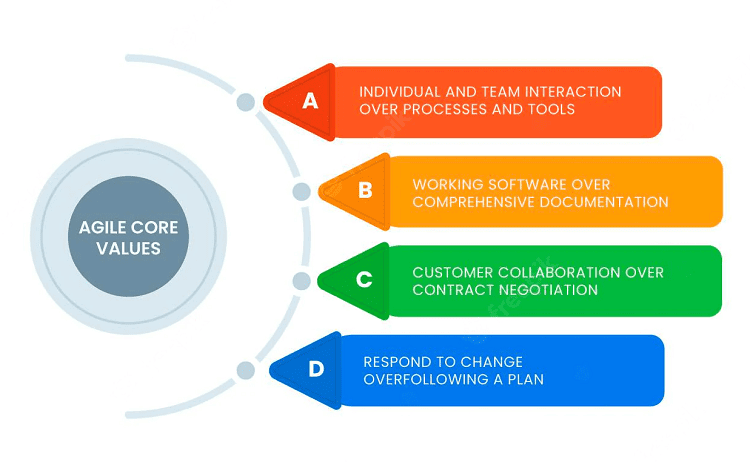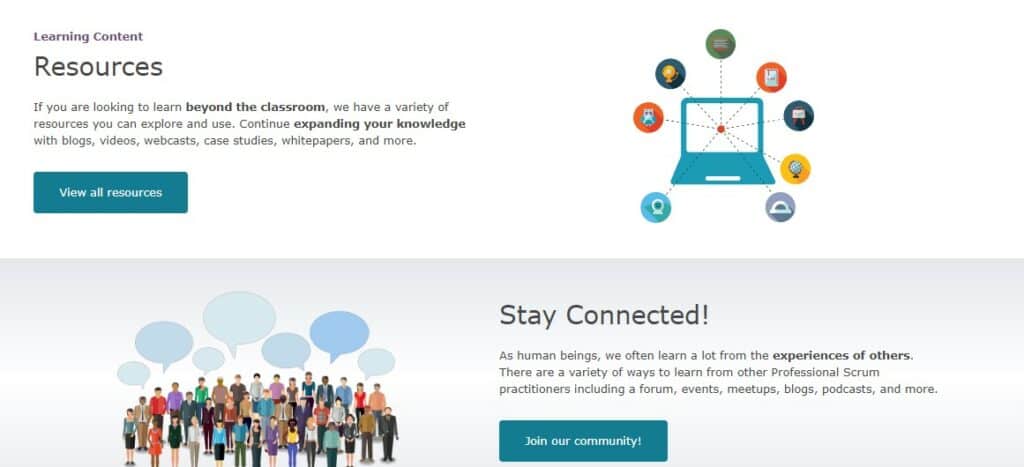Last Updated on December 4, 2023 by Ewen Finser
The success of any project depends on an organization’s ability to manage the development, testing, and delivery processes effectively. Projects that fail to meet their objectives, run over budget, or miss deadlines are usually the result of inadequate management and planning. It’s because of these reasons that project management methodologies exist.
Reducing the risk of failure requires discipline, an organized and proactive approach, and, most importantly, the right methodology. Enter agile project management – a framework that helps teams deliver projects faster and more efficiently.
At its core, agile project management is a set of principles used to create an environment that enables teams to respond quickly to change.
But there’s more to agile project management than just responding to change. It’s also about empowering teams, allowing them to work collaboratively and with autonomy to reach their project goals. This article will explain what Agile is, how it works, and why teams need it to ensure the successful delivery of their projects.
Bottom Line Up Front
Agile delivers value to the customer iteratively and incrementally, focusing on continual improvement through collaboration between cross-functional teams.
An Agile approach to project management helps organizations deliver faster, better-quality results while promoting employee engagement and job satisfaction. It allows teams to adapt quickly to changing customer demands and business objectives with minimal disruption.
Introduction to Agile: What is Agile Project Management?
Agile project management is a revolutionary way to approach the task of managing complex projects. It’s a set of tools and techniques designed to help project teams produce results in an ever-changing environment. Best known for its incremental and iterative approach to development, Agile enables teams to deliver quality products with minimal risk and maximum efficiency.
Agile uses sprints, or short development cycles, to quickly break down and prioritize tasks. This approach allows teams to get feedback from stakeholders more often and make necessary changes sooner rather than later. Each sprint starts with planning and ends with a review, making sure the team is focused on both the big-picture goals and daily objectives.
Agile also builds measures of accountability by introducing regular demos and retrospectives. These measures allow the team to stay on track and identify areas for improvement. In addition, Agile encourages collaboration between all stakeholders, from developers to customers, resulting in more transparent communication and better results.
The principles behind Agile are simple but effective: Break down complex tasks into small, manageable pieces, prioritize each step, and be prepared to adjust quickly. With Agile project management, teams can achieve success while meeting tight deadlines. No wonder it’s the go-to approach for many companies today.
The History of Agile
In the 1970s, the aerospace, defense, and computer industries used traditional project management approaches that led to the creation of obsolete and unneeded products. Some abandoned projects mid-development because the problem being addressed changed before they could deliver a helpful product. Customers didn’t get what they paid for, and companies wasted time and money.
Development methods like Rapid Application Development (RAD), Feature Driven Development (FDD), Extreme Programming (XP), and Scrum all evolved from the need for a better way to manage projects. They shifted the focus from rigidly following plans to responding quickly and efficiently to change. Agile methodologies find their roots in these earlier practices.
How the Agile Methodology Came About
Software development in the 1990s was slow and cumbersome. The Waterfall method dominated the software development landscape and failed to deliver quality products promptly. Imagine the frustration of waiting months for a product to discover it didn’t meet customer needs.
The Agile Manifesto, published in 2001 by a group of 17 software engineers and developers (Agile Alliance), was the first step towards a better way of working. It outlined 12 core values and principles for project management, emphasizing the need for continuous delivery of value, a collaboration between teams, and customer feedback to drive product development.
Agile was a response to the past’s rigid and formulaic software development processes. It moved away from lengthy and drawn-out Waterfall project management phases, focusing on quick iterations with frequent feedback loops. Teams can deliver value faster and more efficiently by breaking a project into smaller chunks. The Agile methodology enables teams to constantly strive for improvements and make necessary changes as the project progresses.
Agile Project Management vs Waterfall Project Management
Waterfall project management is a traditional project management that relies on a sequential approach to completing tasks. This method entails breaking down an entire project into more miniature stages and then completing each step individually while following an order.
On the other hand, Agile Project Management is an iterative approach used for software development projects. This methodology works by rapidly developing the product over several short sprints, adding features, and fixing any issues on the go. The process follows a design, development, testing, and release cycle.
The main difference between Agile Project Management and Waterfall Project Management is their approach. Waterfall relies on a linear order to complete tasks, while Agile utilizes an iterative method that allows for more frequent project revision.
In addition, Agile emphasizes communication throughout the project’s life, whereas Waterfall focuses more heavily on documentation and process.
The Four Values of Agile Project Management
The agile manifesto highlights four core values. These values are the foundation of agile project management and strive to bring a better way of working through collaboration and rapid response.
Below is an overview of each value with an interpretation of what it means for agile project management.
- Individuals and Interactions over Processes and Tools: This value emphasizes the importance of forming strong relationships between team members, customers, stakeholders, and other interested parties. It’s also essential to recognize that processes should be flexible enough to allow individuals to work together efficiently.
- Working Software over Comprehensive Documentation: Agile projects should focus on delivering working software rather than comprehensive documentation, as this is more likely to lead to successful outcomes. Teams can validate ideas and respond quickly to changes by focusing on software development.
- Customer Collaboration over Contract Negotiation: Agile project management values collaboration with the customer over contract negotiation and emphasizes developing solutions that meet the customer’s needs. This requires a collaborative approach to working together, prioritizing customer feedback, and responding quickly to changes or requests.
- Responding to Change over Following a Plan: As projects continually change and evolve, it’s important to respond quickly and effectively. This value encourages teams to anticipate and embrace changes as part of the project rather than sticking rigidly to a plan that might no longer be relevant or applicable.
Although agile prioritizes the items on the right side (individuals, working software, customer collaboration, responding to change) over the items on the left side (Processes and tools, comprehensive documentation, contract negotiation, and following a plan), this doesn’t mean that they are not important aspects of project management.
It’s important to consider all aspects of a project when using an agile methodology.
The 12 Principles of Agile Project Management
Apart from the four core values, the agile manifesto also outlines twelve principles for agile project management. These principles ensure that teams can follow an agile methodology as effectively as possible.
The manifesto outlines these principles as follows:
- The first principle is to satisfy the customer through early and continuous software delivery. Teams should strive to deliver working software as quickly as possible, responding rapidly to customer feedback and changes in the project.
- In the second principle, changing requirements are welcome, even late in the development process. Agile processes harness change by quickly adapting to new information and requirements.
- The third principle is to deliver working software frequently. The principle encourages teams to deliver working software as often as possible, usually a few weeks to a month but the shorter timescale, the better.
- The fourth principle emphasizes collaboration between developers and business stakeholders throughout the project. This collaboration involves working together to ensure mutual understanding, agreement on scope and direction, and regular feedback loops between team members.
- In the fifth principle, teams should strive to build projects around motivated individuals. One should give them the environment and support needed to be successful and the trust that they can get the job done.
- Per the sixth principle, face-to-face conversation within a development team is the best form of communication. As such, teams should strive to have diverse and physically collocated members and, if possible, work in the same space.
- The seventh principle emphasizes working software as the primary measure of progress. Teams should strive to deliver working software, not just artifacts like documents and presentations.
- In the eighth principle, agile processes promote sustainable development. Users should be able to maintain a constant pace over the long term without burning out and sacrificing quality.
- The ninth principle is progressive attention to technical excellence. Good design enhances agility, and the development team should strive for technical excellence throughout a project.
- Simplicity, as the tenth principle, is essential. This encourages teams to focus on what’s important and ignore distractions.
- The eleventh principle states that the best architectures, requirements, and designs emerge from self-organizing teams. These teams should be able to develop creative solutions independently rather than relying solely on top-down management.
- Finally, the twelfth principle is to reflect regularly and adjust accordingly. Continuous reflection and adaptation are integral to agile project management. Teams should regularly review progress, identify areas for improvement, and adjust as needed.
These 12 principles are the core of agile project management and should be at the heart of any successful agile project. Understanding these principles can help teams make informed decisions and ensure projects progress in the intended direction.
How Does Agile Work?
Agile is more of a mindset than a specific process or framework. It bases its methodologies on the concept of continuous improvement and flexibility. Thus, it’s an open-ended and adaptive way of working with no exact formula for success.
Agile Essentially does the Following
- Empowers individual software developers in the development process by encouraging them to make decisions within a structured framework
- Takes a short-term, iterative approach to software development by breaking down large projects into smaller pieces that can be completed quickly
- Uses the collective experience of team members to keep projects on time and budget
- Encourages collaboration between all parties involved in the project
- It provides room for trial and error as well as experimentation
- Recognizes that change is inevitable and builds in flexibility to accommodate the changes that may occur during the development process
Given that agile is open-ended and adaptive, there is no one-size-fits-all approach for a project. Each team must find its way to work within the agile framework and apply the principles of agile project management.
At the same time, teams must also recognize that agile is not a panacea for all projects and that sometimes other methods may be more appropriate. Regardless of how one chooses to work within the agile framework, it is essential to remember that agility only works if team members are invested in their results and engaged in the process.
An Overview of the Five Phases of Agile Project Management
Projects that use the agile framework often follow a five-phase process. Teams may cycle through these phases multiple times during a project, depending on their needs.
- Envisioning: An agile project typically starts with a vision of the end product. This phase involves researching and understanding customer needs, creating a roadmap for achieving their goals, and defining success criteria.
- Speculating: During this phase, teams brainstorm and speculate about potential features and solutions. They also determine which features will be most valuable to customers and prioritize them accordingly.
- Exploring: This phase is the core of agile project management. Teams explore different ways to build the product and iteratively develop prototypes they can test with customers. It helps them ensure they’re on the right track and progressing toward their vision.
- Adapting: As teams build and test their prototypes, they learn more about customer needs and refine their product accordingly. This phase emphasizes flexibility and encourages teams to iterate quickly in response to user feedback.
- Delivering/close: The last phase is the delivery of the final product. Teams review their work, make any necessary changes, and then deliver the final product to stakeholders.
As teams work through these steps, they should regularly review progress, identify areas for improvement and adjust as needed. By doing so, they create a cycle of continuous improvement that keeps the project on track and helps ensure its success.
Agile Frameworks Explained: Top Six Types of Agile Methodologies
Agile frameworks are the various processes and practices that help teams work within the agile framework. In essence, these provide a structure to ensure consistency and success in project management. Some people refer to them as subsets or variations of the agile methodology.
Here are six of the most popular agile frameworks:
1. Scrum
Perhaps the most popular agile framework, Scrum, is a lightweight process emphasizing collaboration and iterative development cycles (sprints) to deliver the highest value features first. It is highly flexible and includes roles such as Product Owner, Scrum Master, and Development Team.
There’s often confusion between Scrum vs. agile. Scrum is a subset of agile, and it’s more prescriptive in its approach to project management. Scrum is a specific variant of agile that follows certain rules, processes, and procedures.
2. Kanban
Kanban is an agile framework for visual project management that emphasizes limiting work-in-progress (WIP). It uses boards to visualize tasks and their progress from start to completion and workflow limits to prevent teams from taking on too much work at once.
3. Lean
Lean is an agile methodology that focuses on reducing waste and eliminating steps or processes that don’t add value to the product. Organizations use lean to focus on customer value, improve efficiency and ensure that the process is continuously improving.
4. XP (Extreme Programming)
XP is an agile methodology designed to create high-quality software in a short amount of time. It emphasizes communication between developers, customers, and users and feedback from each stakeholder throughout the development cycle. An XP team consists of a customer, developers, and a coach.
5. FDD (Feature Driven Development)
FDD is an agile framework that emphasizes the development of features over processes. It includes five key activities: developing an overall model, building feature lists, planning by feature, designing by feature, and building by feature.
Each activity helps teams develop the highest-value features first and ensure they are testing, validating, and delivering them properly.
6. Crystal
Crystal is an agile methodology that focuses on people and communication. Like other agile frameworks, it encourages collaboration and emphasizes flexibility. It also includes techniques such as pair programming and collective ownership to ensure that teams deliver the highest quality code quickly.
Other Agile Frameworks Include
DSDM (Dynamic System Development Method), Scaled Agile Framework (SAFe), Disciplined Agile, Adaptive Software Development, and Extreme Modeling. Each of these frameworks has its unique approach to agile project management and may be more appropriate for certain projects than others.
FAQs
Question: What is Agile Project Management Good for?
Answer: Agile is an ideal methodology for projects with many unknowns and requirements that may change quickly. It’s also beneficial when teams must move fast and deliver results rapidly.
Agile is most commonly used in software development, but it can apply to any project requiring collaboration and continuous improvement.
Question: What are the Benefits of an Agile Approach?
Answer: The most significant benefits of an agile approach are improved communication and collaboration, faster delivery, better quality products, increased customer satisfaction, higher team morale, and more efficient use of resources. Agile also enables teams to adapt quickly to changing requirements or unexpected challenges.
Question: What are the Three Constraints of an Agile Approach?
Answer: Three constraints of an agile approach are time, scope, and cost. Time and scope are typically fixed, while cost is variable. Teams must focus on delivering the highest value within a set timeframe and given budget.
Closing Thoughts
Agile project management is a powerful tool for teams to deliver results quickly and efficiently. Its flexibility enables teams to adapt to changing requirements, while its focus on collaboration creates an environment of continuous improvement.
Teams can use any of its various frameworks to ensure that their projects progress with high quality and customer satisfaction. The key is to find the right approach for your team and project needs, as each agile framework has its strengths and weaknesses. With careful consideration, you’ll be able to get maximum value from agile project management.






